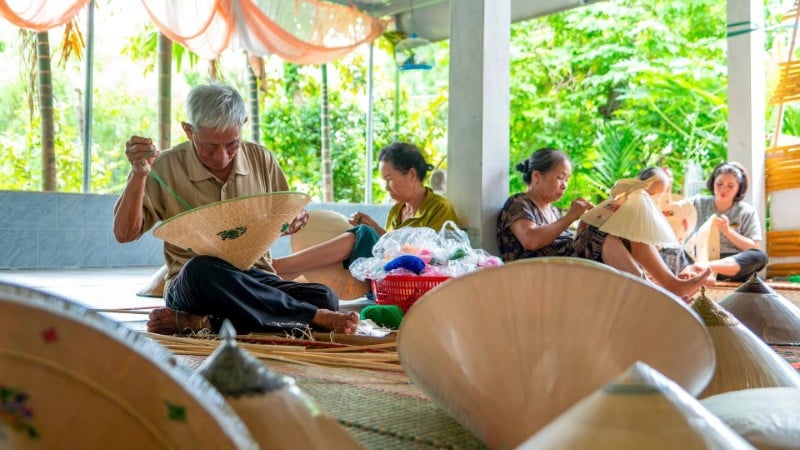
For the artisans in Phu Gia horse hat village, Xuan An commune, Gia Lai province (Cat Tuong commune, Phu Cat district, former Binh Dinh province), continuing to work every day to preserve, promote and create unique horse hats, a national intangible cultural heritage, is a joy.
About 30 minutes from Quy Nhon ward center, Xuan An new rural commune was established based on the merger of two communes Cat Nhon and Cat Tuong with a population of more than 33,000 people. From National Highway 19B, turn onto the concreted provincial road DT 365 to each hamlet of Xuan An commune, we feel the fresh, peaceful air of the craft village here.
Vice Chairman of Xuan An Commune People's Committee Ho Van Tuan shared that Phu Gia horse hat is a unique and long-standing traditional handicraft product of the old Binh Dinh province. On April 9, 2024, Phu Gia horse hat making was recognized by the Ministry of Culture, Sports and Tourism as the province's 5th national intangible cultural heritage, further supporting the locality in preserving the traditional cultural values and characteristics of the hat making craft village.
On April 9, 2024, Phu Gia horse-hat making was recognized by the Ministry of Culture, Sports and Tourism as the province's 5th national intangible cultural heritage, further supporting the locality in preserving traditional cultural values and characteristics of the hat-making craft village.
We visited the family of Meritorious Artisan Do Van Lan, who is 78 years old this year, the fourth descendant of a family with five generations of making horse hats. According to Mr. Lan, the horse hat making craft village has a history of about 260 years. The years 1955-1960 were the heyday of the craft village with 300 households making them, currently there are about 100 households still maintaining the production stages. "The horse hat is different from the hat people wear when going to the market or to the fields, it has 5 layers on top of each other, while the normal hat has 1 layer, so it is thicker, heavier, and more durable. Even without using any chemicals, as long as the traditional preparation process is followed correctly, the hat will last for 50-70 years," Mr. Lan added.
Through each generation, hat-making families keep the most beautiful pair of horse-hats as family heirlooms. Thanks to that, Meritorious Artisan Do Van Lan's house is currently displaying four pairs of horse-hats that are 120 years old, and the "youngest" hat is 75 years old, left by his mother before she passed away. The hats only lose their color over time but are still usable.
Phu Gia horse hats are made from the raw materials of the palm leaves, the giang plant, pineapple roots, fishing line and embroidery thread. It takes 3-5 days to create a complete, neat horse hat, even nearly a month for more complex designs.
The process of making a complete horse hat includes 13 steps: Weaving the ribs; threading the longitudinal ribs; tying the ribs; making the brim; tying the cone; embroidering patterns; cutting leaves; pinning spirals; covering leaves; sewing the hat; cracking the hat; making the lens; and finishing the shell. Of these, there are three main steps: Making the ribs, weaving the ribs and sewing the hat, which will be undertaken by some villages and hamlets. Phu Gia village is in charge of the hat sewing.
First, the artisan splits the ribs into small pieces and smooths them, then weaves the ribs. Next, the artisan places the ribs into the hat frame and places palm leaves on top of the ribs, then proceeds to sew the hat.
In the village, there are two types of hats: the normal type has a bare cone, on top there is a bunch of colorful threads fluttering like a flower, these hats are relatively cheap, from 40,000-50,000 VND/hat. Hats made according to this traditional model cost from 300,000-500,000 VND/hat and can be more expensive, depending on the size and patterns.
For the more eye-catching horse hats, the top of the hat is attached with a silver or tortoiseshell cap with carvings. The hat strap is made of red or blue silk strips, with a tassel under the chin. These horse hats are very popular with tourists because of their uniqueness and durability.
According to the stories passed down from the ancients, in the past, high and low officials, kings and princesses of the dynasties had silver headdresses. They had many types of patterns, high officials had dragons, unicorns, turtles, and phoenixes; carved in them were blessings like the eastern sea, longevity like the southern mountains, and good luck. Princesses had lighter patterns, and the pair of plum, orchid, cuc, and bamboo were not allowed to wear dragons, unicorns, turtles, and phoenixes because they were only for men.
Mr. Lan's family currently has a collection of 18 cones, including eight ancient ones and 10 newly researched and made innovative ones. To fix the cone, there will be a screw to screw the cone to the cone, the cone weighs less than 100g. Today's horse cone cones cost 2.5 million VND, made of copper. "For me, every day I create a different model than my ancestors, the products are not the same, they are unique, always thinking to change", Mr. Lan shared.
2025 can be said to be a very happy and exciting year for Mr. Do Van Lan. Last May, he was awarded the title of Meritorious Artisan by the President. Right before our visit, he was also one of the typical participants in the Gia Lai Province Patriotic Emulation Congress for the period 2020-2025. These are the recognitions of the Party, the State as well as Gia Lai Province for his contributions in preserving and promoting the values of Phu Gia horse hat making.
According to Deputy Director of the Department of Culture, Sports and Tourism of Gia Lai province, Ms. Nguyen Thi Kim Chung: In the past time, implementing the pilot project of developing tourism in traditional craft villages in Binh Dinh province until 2025; The Department of Tourism (old) has deployed tourism development in craft villages with the following contents: training on tourism skills in the form of direct guidance for family members and people interested in and in need of tourism in Phu Gia horse hat making craft village, building a signboard for craft village tourism and organizing tourism in craft villages including Phu Gia horse hat making craft village. “In the context of digital transformation, the Department of Culture, Sports and Tourism has identified linking craft village activities with tours and tourist routes as one of the key tasks to enhance cultural values and increase income for people. We are synthesizing content related to craft village products, creating QR codes to promote craft village tourism, introducing products, connecting online sales to expand consumption channels, increase income for households and contribute to sustainable tourism development,” Ms. Kim Chung added.
Mr. Lan and Mrs. Nguyen Thi Tam, along with their colleagues, are still diligently and diligently keeping the "fire" for Phu Gia horse hat weaving to continue to be maintained. However, life is increasingly developing and modernizing, making people easily forget old values and chase after new things. That is what Mr. Lan and his wife are worried about, fearing that the horse hat weaving craft village will be lost and disappear. “I am 78 years old this year, the Phu Gia horse hat making craft has been certified as a national intangible cultural heritage, I hope Gia Lai province will support a sum of money to invite 10 children who know how to make hats, I will directly improve my skills to gradually replace me in preserving this traditional craft, develop it better, bring income to the locality, serve domestic and foreign tourists. From these 10 children, 4-5 highly skilled children can be developed because this is a handicraft product that requires sophistication, if it does not achieve sophistication, it cannot be successful”, artisan Do Van Lan worries.
Source: https://nhandan.vn/phat-huy-gia-tri-nghe-cham-non-ngua-phu-gia-post913000.html




![[Photo] Prime Minister Pham Minh Chinh launched a peak emulation campaign to achieve achievements in celebration of the 14th National Party Congress](https://vphoto.vietnam.vn/thumb/1200x675/vietnam/resource/IMAGE/2025/10/5/8869ec5cdbc740f58fbf2ae73f065076)

![[Photo] Prime Minister Pham Minh Chinh chairs the Government's online conference with localities](https://vphoto.vietnam.vn/thumb/1200x675/vietnam/resource/IMAGE/2025/10/5/264793cfb4404c63a701d235ff43e1bd)

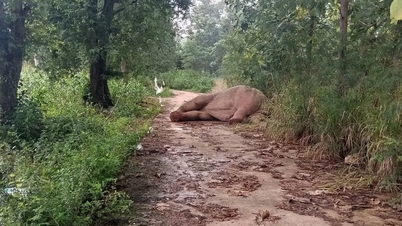

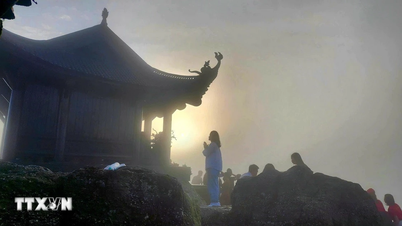

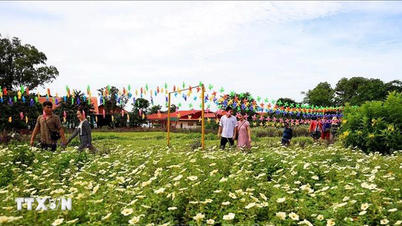
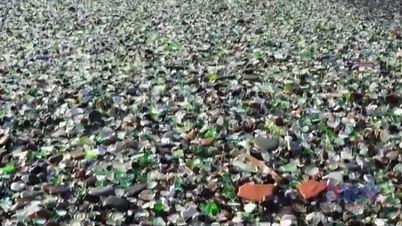
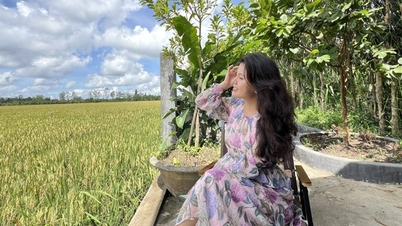

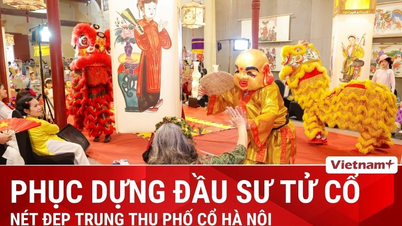





![[Photo] Prime Minister Pham Minh Chinh chairs the Government's online conference with localities](https://vphoto.vietnam.vn/thumb/402x226/vietnam/resource/IMAGE/2025/10/5/264793cfb4404c63a701d235ff43e1bd)



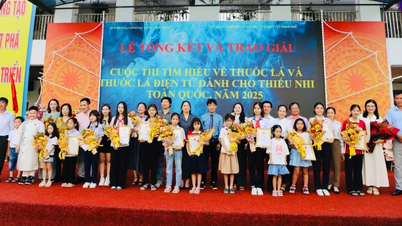

























![[VIDEO] Summary of Petrovietnam's 50th Anniversary Ceremony](https://vphoto.vietnam.vn/thumb/402x226/vietnam/resource/IMAGE/2025/10/4/abe133bdb8114793a16d4fe3e5bd0f12)

![[VIDEO] GENERAL SECRETARY TO LAM AWARDS PETROVIETNAM 8 GOLDEN WORDS: "PIONEER - EXCELLENT - SUSTAINABLE - GLOBAL"](https://vphoto.vietnam.vn/thumb/402x226/vietnam/resource/IMAGE/2025/7/23/c2fdb48863e846cfa9fb8e6ea9cf44e7)














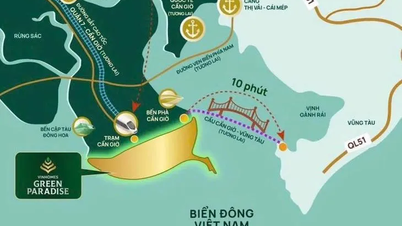
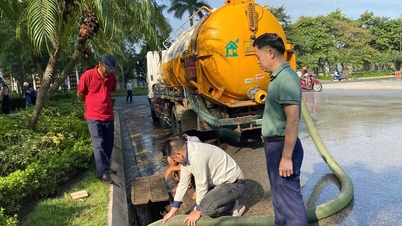


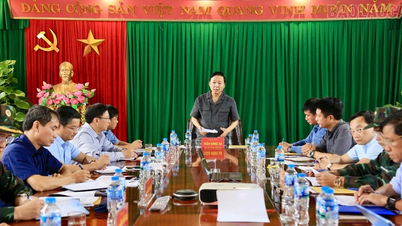

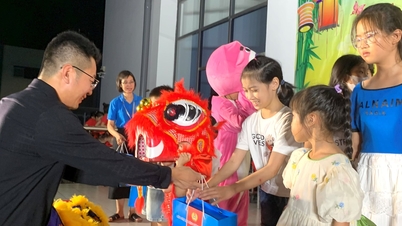

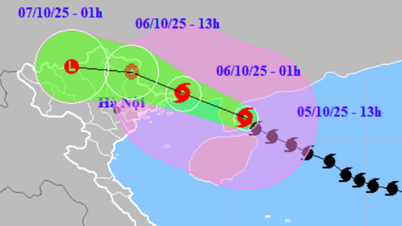














Comment (0)